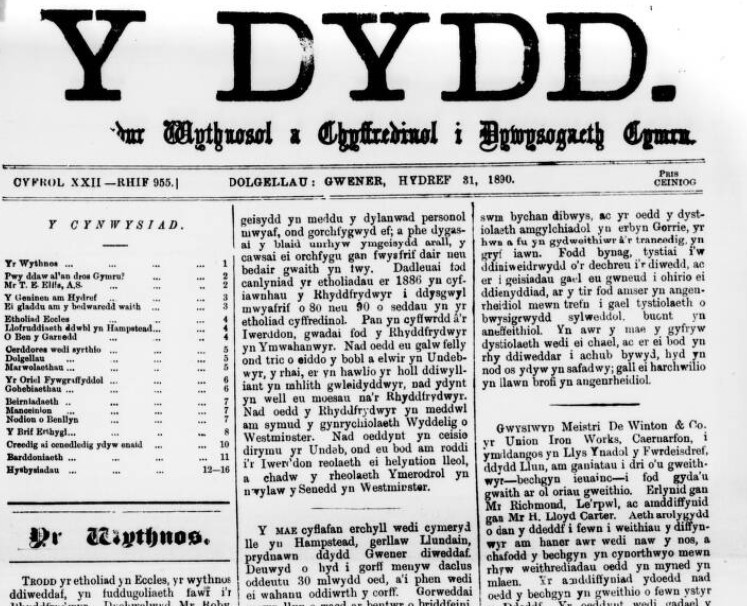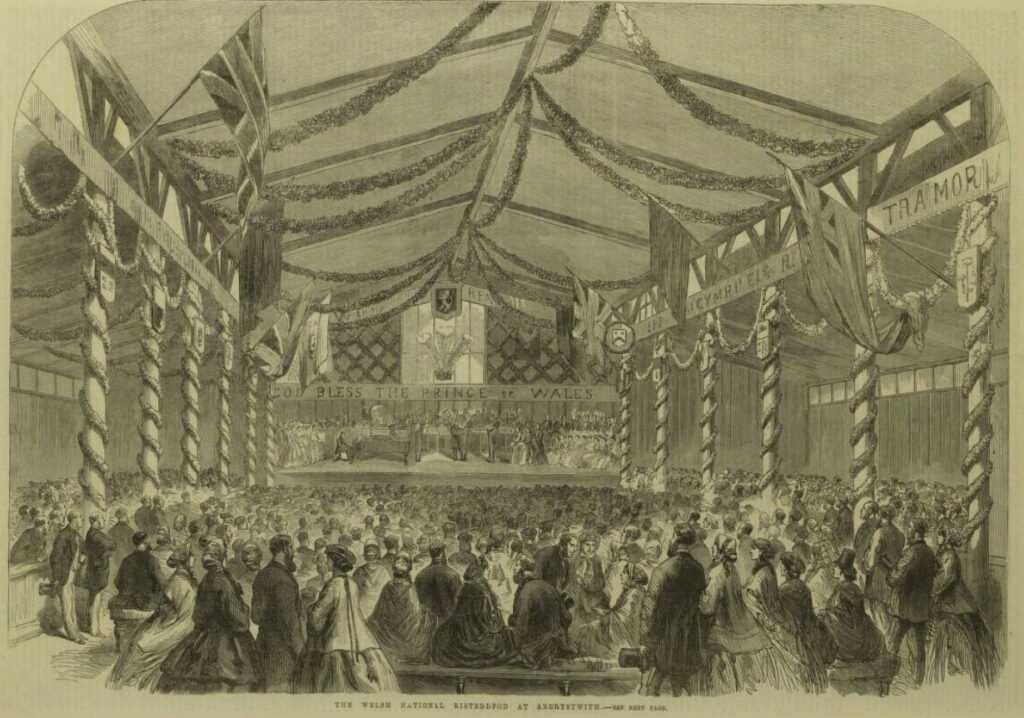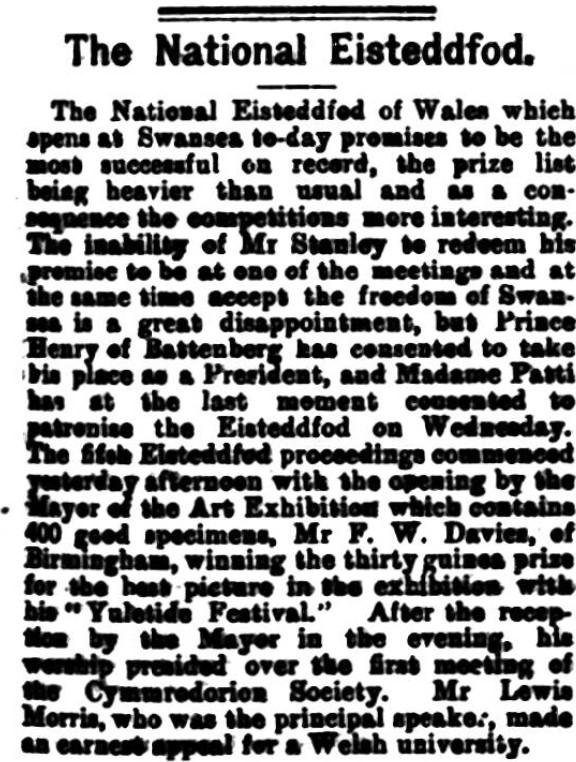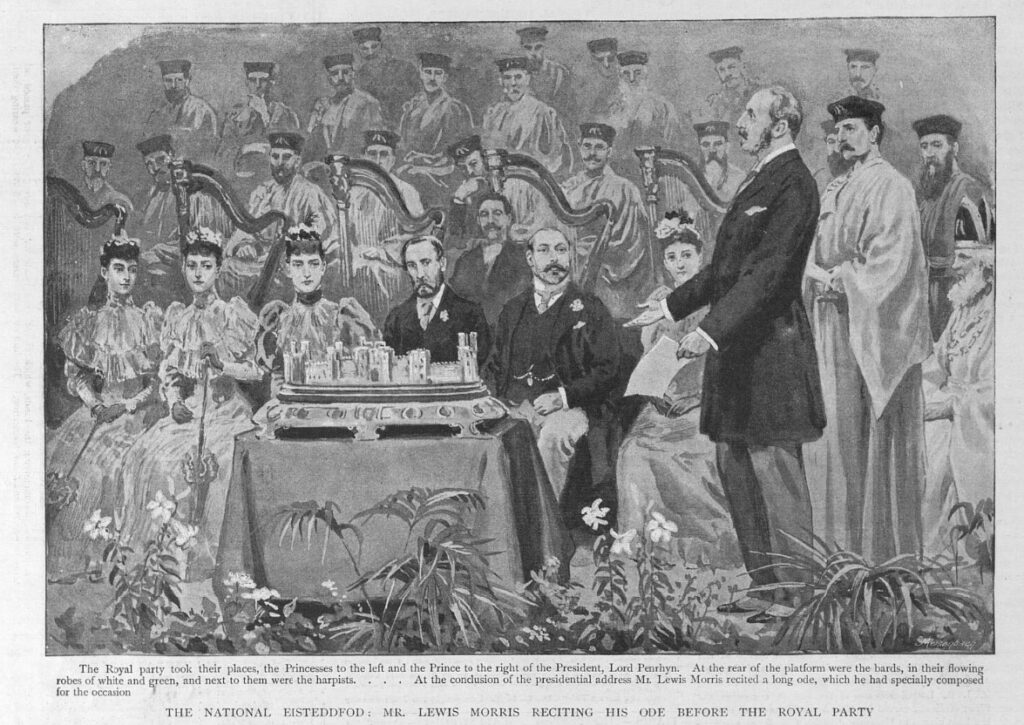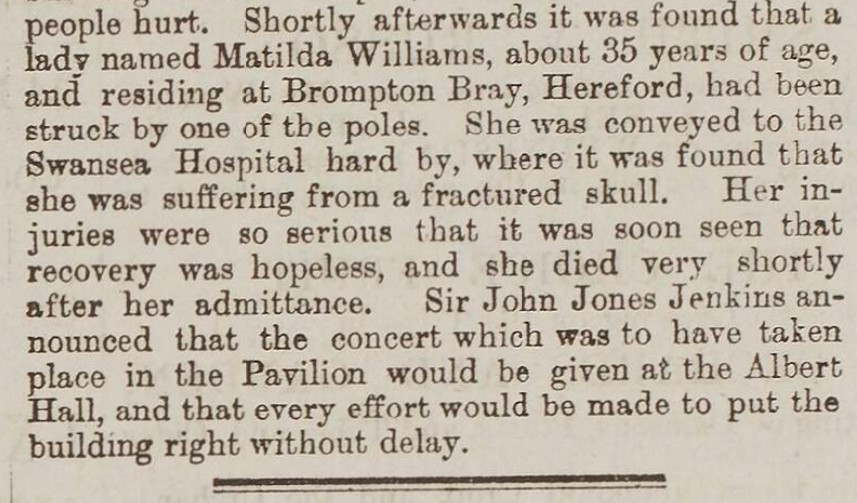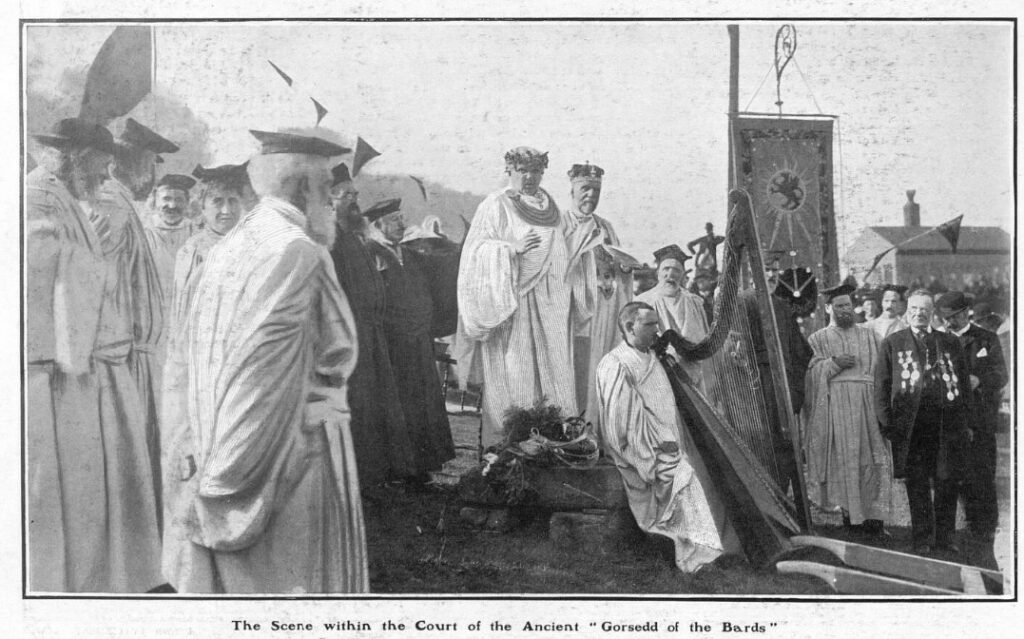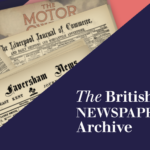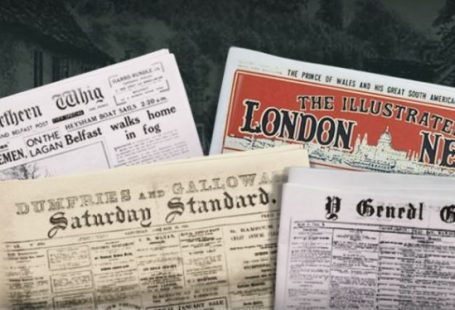This week at The Archive we are delighted to welcome three wonderful and brand new Welsh language newspapers to our collection, alongside 75,422 brand new pages. Meanwhile, from Holborn to Hornsey, from Nelson to North Middlesex, we’ve updated six of our existing titles from Scotland and England.
So read on to discover more about our new and updated titles of the week, as well as to learn about the National Eisteddfod of Wales in 1891, the largest of several eisteddfodau that are held in Wales, which in that particular year did not go to plan.
Register now and explore the Archive
The first of our trio of new Welsh language newspapers this week is Llais Y Wlad, which was published in the cathedral city of Bangor between 1874 and 1884. Llais Y Wlad, which translates to ‘Voice of the Country,’ was a weekly Conservative newspaper that was established by Kenmuir Whitworth Douglas, who was also known as J.K. Douglas.
Filling eight pages, and appearing every Friday, Llais Y Wlad made its debut on 3 February 1874 and dubbed itself as a ‘cheap Welsh newspaper.’ Edited initially by Thomas Tudno Jones from 1874 to 1880, and then by Evan Jones, who hailed from Llangristiolus, Anglesey, by the end of its lifetime the paper had become independent, and had loosened its ties to the church.
The second of our Welsh language newspapers to join our Archive this week is Y Dydd, which was established by Samuel Roberts in 1868 and circulated ‘throughout North Wales generally.’ Published in Dolgellau, the historic county town of Merionethshire, Y Dydd filled an impressive sixteen pages and cost just one penny.
Liberal in its politics, Y Dydd featured general, political and religious news, as well as poetry, correspondence, and a focus on Welsh news. Translating to ‘The Day,’ Y Dydd later merged with Tyst Cymreigh to form Tyst a’r Dydd, although the publication later reverted to its original title of Y Dydd. In 1954 Y Dydd merged with the Corwen Chronicle and Border Advertiser, before ceasing publication in 2017.
The final of new Welsh language newspapers this week is Y Gwladgarwr, or ‘The Patriot,’ which was first published on 15 May 1858 in Aberdare, Glamorgan. The title was established by David Williams, Abraham Mason and William Williams, although Walter Lloyd became proprietor of the publication soon after its inception, in November 1859.
This weekly title appeared every Saturday, filling eight pages at the cost of two pence. Y Gwladgarwr was Liberal in its politics, supporting the causes of the working classes, as well as showcasing Welsh literature. Indeed, this Welsh language title provided Welsh poets and authors the opportunity to publish their work, with poetry editors over the years including William Williams and William Thomas.
With the motto of ‘freedom of all degrees,’ this lively title also featured a philosopher’s corner, and sports reports. Y Gwladgarwr circulated mainly in South Wales.
That’s it from our new Welsh language titles of the week, but we have also updated six of our existing titles. Updates this week are to four of our London titles (Holborn and Finsbury Guardian, Islington News and Hornsey Gazette, North Middlesex Chronicle and St. Pancras Guardian and Camden and Kentish Towns Reporter), whilst we have also added new pages to Dundee-based Thomson’s Weekly News, the popular national title with ‘the feelgood factor.’ Rounding off our updated titles this week is Lancashire newspaper the Nelson Leader, to which we have added the year 1918.
The National Eisteddfod of Wales – Swansea, August 1891
Held every August, the National Eisteddfod of Wales is an eight day competition of music and poetry, with one its most important events being the Coroni’r Bardd, or Crowning of the Bard, awarded to the winner of the Pryddest, which is the competition for poetry written in free verse. The Eisteddfod traces its origins all the way back to 1176, to the bardic competition which was held by Lord Rhys at Cardigan Castle. Today’s National Eisteddford of Wales, however, is an organisation that originated in 1861, with the inaugural event taking place in Aberdare.
Thirty years after this first event, Wales was once again gearing up for its National Eisteddford. Indeed, we find mention of it in our new Welsh language title Y Dydd, under the heading ‘Eisteddfod Genenlaethol.’ The author of this blog sadly does not have any Welsh language knowledge, so has reverted to the other newspapers in our collection to tell the story of the National Eisteddfod of Wales of 1891.
Welsh newspaper the South Wales Daily Telegram on 18 August 1891 reported how:
The National Eisteddfod of Wales which opens at Swansea to-day promises to be the most successful on record, the prize list being heavier than usual and as a consequence the competitions more interesting.
Meanwhile, the National Eisteddfod was also reported on by newspapers in England, as the opening of the event was marred by a tragic accident. Worcestershire based newspaper the Bromsgrove & Droitwich Messenger reported on the day’s events, which began innocuously enough, on 22 August 1891:
The National Eisteddfod of Wales was opened in the Victoria-park, Swansea, on Tuesday. The weather in the morning was brilliant, and thousands of excursionists from all parts of the Principality visited the ancient borough. As soon as the doors of the gigantic pavilion were thrown open there was a rush for seats. The structure, built of wood, was decorated with devices, shields, and flags of all kinds.
Many ‘well-known Welshmen’ took their seats at the front, with Sir John T.D. Llewelyn, the Mayor of Swansea, acting as president for the day. He addressed the crowd, the Bromsgrove & Droitwich Messenger outlining how:
He said the whole use and object of the Eistoddfod was to promote the general welfare of Wales and Welshmen, by encouraging the culture of music and other arts. The Eistoddfod was said to be the means of preserving the traditions and perpetuating the glories of olden time, a more romantic time than our own prosaic age, and even criticised on those lines it was worth preserving. But it did much more. It taught the lesson that they should not rest and be thankful, and it encouraged them to look forward more hopefully and extend the fullest encouragement to those who were striving to find light, to those who were earnestly seeking to be improved.
The first competition of the National Eisteddfod and ‘chief event at the opening of the meeting was the orchestral band competition.’ Three orchestras, namely the Cardiff Orchestral Society, Newport Orchestral Society, and Swansea Musical Society, all played the same piece, Haydn’s Symphony in D. The Bromsgrove & Droitwich Messenger recorded how the Cardiff orchestra was victorious, scooping the £50 prize. But after this, things took a turn for the worse.
It was, as the Bromsgrove & Droitwich Messenger describes, the weather that threw events ‘into confusion,’ when a storm broke out. The newspaper reported how:
The first signal of its approach was the darkening of the interior and flapping of the large central covering. Then the architect (Mr. Edward Bath) could be seen running up through the area accompanied by some workmen, but before anything could be done the rain fell in torrents, and people in the galleries began to move lower down to escape the heavy drops which found their way between the slender boarding. Hardly had they started from their places when the whole pavilion seemed to bend under the rush of the wind, and amid cries of dismay, the central masts were noticed to give way and the whole of the canvas to drop heavily into the area.
The collapse of the pavilion caused a chaotic scene, the Bromsgrove & Droitwich Messenger going on to describe how:
For a moment the whole place was in a state of great excitement. A rush was made by the reserved seat holders for the platform, and the pressmen were soon engaged assisting ladies over the press table which divides the platform from the area. Others burst open the doors to make their escape, for it was feared the whole building would collapse; and cries were heard as of people hurt.
Tragically, the newspaper reported how one Matilda Williams, a 35-year-old woman from Herefordshire, had been struck by one of the falling poles. She was taken to the nearby Swansea Hospital, ‘where it was found that she was suffering from a fractured skull.’ Sadly, nothing could be done to save her, and ‘she died very shortly after her admittance.’
However, despite this tragic accident, the show had to go on. The Bromsgrove & Droitwich Messenger recorded how Sir John Jones Jenkins announced that the next concert was take to take place at the Albert Hall, ‘and that every effort would be made to put the building right without delay.’
Find out more about the National Eisteddfodau of Wales, Welsh history, and much more besides, in the pages of our newspapers today.
New Titles
| Title | Years Added |
| Llais Y Wlad | 1874, 1876, 1878-1884 |
| Y Dydd | 1877-1883, 1886-1891 |
| Y Gwladgarwr | 1858-1860, 1866, 1875, 1877-1878, 1880-1882 |
Updated Titles
This week we have updated six of our existing titles.
You can learn more about each of the titles we add to every week by clicking on their names. On each paper’s title page, you can read a FREE sample issue, learn more about our current holdings, and our plans for digitisation.
| Title | Years Added |
| Holborn and Finsbury Guardian | 1875 |
| Islington News and Hornsey Gazette | 1898, 1909 |
| Nelson Leader | 1918 |
| North Middlesex Chronicle | 1898 |
| St. Pancras Guardian and Camden and Kentish Towns Reporter | 1875, 1888 |
| Thomson’s Weekly News | 1925, 1931 |
You can keep up to date with all the latest additions by visiting the recently added page. You can even look ahead to see what we’re going to add tomorrow.



